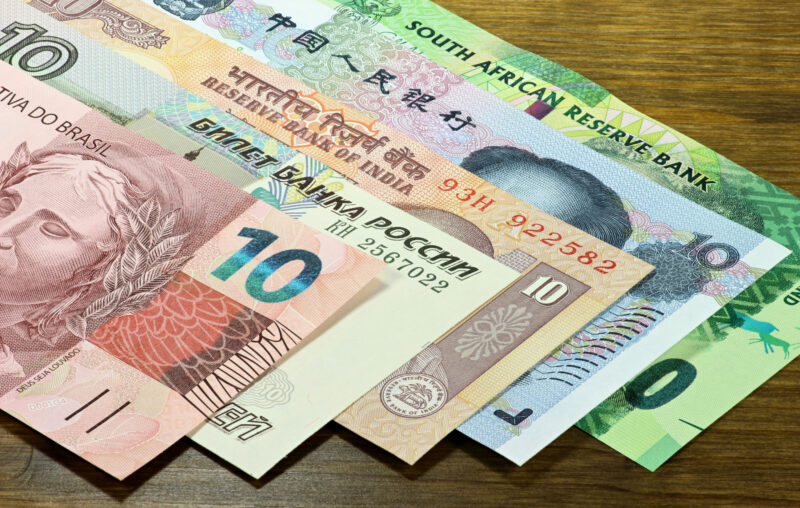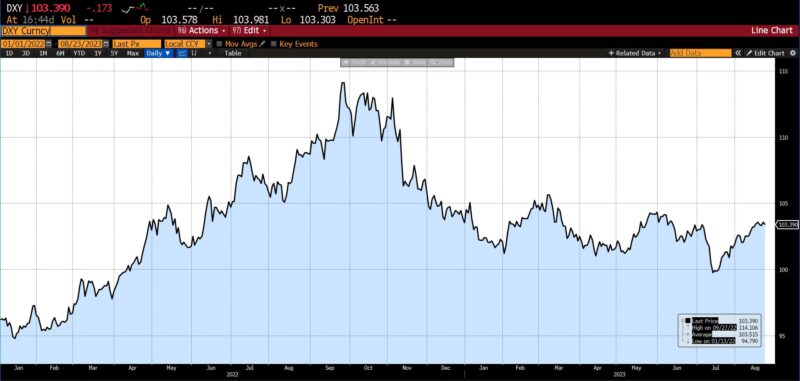[ad_1]

The a lot anticipated fifteenth BRICS (Brazil, Russia, India, China, South Africa) Summit has begun in Johannesburg, South Africa. As anticipated, a central subject is difficult the worldwide dominance of the greenback in worldwide enterprise and commerce. Russia and China are main an effort to not solely strengthen cooperation between the 5 nation BRICS core however to increase the membership of BRICS right into a ‘BRICS+.’ An estimated 40 nations have indicated an curiosity in becoming a member of the present BRICS bloc.
The present dedollarization wave started shortly after the Russian invasion of Ukraine in February of 2022. Amongst a raft of different sanctions, Russian monetary establishments had been ejected from the SWIFT messaging system and a whole bunch of billions of Russian-owned greenback reserves had been seized. As well as, a litany of worldwide disruptive coverage missteps by the Federal Reserve within the wake of the COVID pandemic have infected broad anti-dollar sentiment. The incommodious debt ceiling maneuvers in Could 2023, adopted by the second-ever downgrade of the US credit standing, have solely fortified the case of greenback oppositionists.
CNY USD spot change charge (2022 – current)

(Supply: Bloomberg Finance, LP)
The checklist of countries expressing their need to hitch the present BRICS group is geographically farflung (Kazakhstan versus Cuba), economically numerous (Argentina versus Indonesia), and culturally/traditionally contrasting (Bolivia versus Ethiopia). However some would undoubtedly have extra consequential results on the aim of making greenback options than others. The inclusion of Saudi Arabia, United Arab Emirates (UAE), and a handful of different oil producing nations would carry not solely financial heft however the potential for short-term, drastic modifications in world oil markets pricing and settlement.
A primary step in distancing from the usage of the greenback can be buying and selling in native currencies. An instance of this was seen two weeks in the past when India executed its first oil commerce with the UAE denominated in rupee. That take a look at having been profitable, a real-time fee system between the 2 nations is at present in growth. However low buying and selling volumes and volatility make buying and selling when it comes to smaller, much less liquid currencies difficult and doubtlessly pricey. The drop in each the worth of the yuan (down 5 p.c YTD) and the ruble (down 16 p.c YTD) have, moreover, diminished the standing of their respective governments as sagacious financial directors. (By comparability the greenback, as measured by the DXY index, has risen 1.1 p.c since January 1st.)
RUB USD spot change charge (2022 – current)

(Supply: Bloomberg Finance, LP)
Anticipating these criticisms–or maybe in gentle of them–more moderen proposals have instructed BRICS+ avoiding {dollars} by buying and selling in treasured metals or by a commodity-backed forex. Central banks world wide have been buying gold at report ranges over the previous 12 months or two owing to the return of first-world inflation and post-COVID financial strains. One other concept that has been bandied about, each with respect to escaping greenback hegemony and to fight dedollarization, is the event of stablecoins in varied types.
As with all political jamboree, particularly one so broadly watched by allies and adversaries alike, the primary day of the BRICS Summit has been illustrated by grandiose speech: a few “spirit of openness” (Xi), concerning the progress of dedollarization being “goal [and] irreversible” (Putin); and about making a “multilateral establishment, not an unique membership” (da Silva). Speak apart, the p.c of world GDP accounted for by the BRICS nations has not too long ago overtaken that of the G-7. With the addition of latest nations, which might be introduced throughout the subsequent twenty-four hours, the GDP illustration of the BRICS+ amalgamation could dwarf the latter. On the similar time most of these nations have solely an ephemeral fealty to non-public property rights, formidable capital controls, are avowedly interventionist, and admit a number of different options which make them less-than-desirable locations to do enterprise, a lot much less reserve-currency issuers.
Competing narratives of the greenback’s future are being sketched concurrently: not solely in Johannesburg, South Africa however 9800 miles away in Jackson Gap, Wyoming. Which of these conflicting visions comes closest to realization, or whether or not one other eventuates, stays to be seen. The fragility of the second is even higher conveyed by noting that whereas Argentina has expressed a need to hitch BRICS and is in attendance on the assembly at this time, it’s dollarization, not dedollarization, which is definitely happening at residence. (The importance of India being the primary nation to land a spacecraft on the south pole of the moon–additionally at this time–could be included on the reader’s discretion.)
DXY Index (2022 – current)

(Supply: Bloomberg Finance, LP)
The US greenback is prone to stay a reserve forex for a really very long time: know-how, establishments, and practices have entrenched in it that position. It could, because it did with the British Pound for a number of many years, share that spot with one other, or different, currencies. Certainly, a newfangled BRICS+ forex could discover a place alongside it or them, whether or not its use owes to superior financial properties or just a need to spurn the usage of the US greenback.
Nevertheless lengthy that takes to happen and even when it doesn’t, the contours of worldwide monetary relations are altering quickly, maybe irrevocably. Way more essential than verbal fusillades or untenanted monetary statistics are two decisive components. The primary is, whilst inconsistent because it has grow to be, a continued dedication to free market practices in good instances and dangerous. The second, much more critically, is a return to sound cash. The enduring robustness of the US economic system relies upon upon each–whatever the pecking order of world reserve currencies.
[ad_2]
Source link




